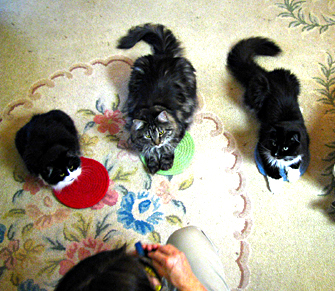Clicker training is not your Grandpa’s obedience training. You don’t force the cat to do anything. This means your cats choose to do the behavior instead of being coerced, which makes them think and learn for themselves. It also makes them your partners in training, rather than your subjects. It’s not about obedience. It’s about learning. And fun!
It’s quieter at first. The click tells them what to do, not your voice. There’s no point in barking commands at someone who hasn’t been taught yet what the command means. When the cat proves it knows the behavior by voluntarily doing it 8 times out of 10, adding a voice command will make sense to the cat…and stick.
The first step in clicker training is to charge the clicker. In other words, charging lets the animal know the clicker is connected to a reward. As Karen Pryor says, every time you click, you’re saying, “That’s it! I’ll pay you for exactly that!” You give the cat a treat and then immediately click so the two are permanently associated. You should only need to do this a few times before the cat understands the click is connected to the treat.
Pet stores sell box clickers, but they may be too loud for some cats. Try a couple of clicks with one and if your cat reacts negatively, use either a softer clicker like the I-click, a ballpoint pen or simply your mouth. A mouth click has the advantage of freeing up your hands for treats and props, but may not be as consistent as a mechanical clicker.

Clicker trainers say that animals tend to revert to their first learned behavior. Cats are hardwired to sit motionless for long periods of time when they hunt, so if you train a cat to Sit for its first behavior, you’ll have a cat who’s trained not to move. Instead, cat trainers recommend touching the target stick as a first behavior. Targeting rewards the animal for touching a stick of some kind, like a chopstick or dowel. This can be used to help shape a behavior through luring, but shouldn’t be relied on too heavily or the animal will always wait for a prompt with a prop, not offering its own behavior.
For a second behavior, many cat trainers recommend go-to-mat (let’s call it Mat for simplicity): using the prop of a mat to train the cat to go to a particular place and wait. The difference between this and a Sit is that a Sit-trained cat will tend to be glued to one place, while a Mat-trained cat can be moved around by moving the prop. It’s a variation of the Places Please behavior that Pryor describes in her book, Clicker Training for Cats.
Mat can also be used to keep cats separate but engaged while waiting their turn for training (think tigers on podiums). If you have more than one cat to train, this is essential. Any portable piece of fabric works well, like a trivet or small placemat.
Another big difference between training cats and training dogs is that most dogs are very food-oriented. Most cats, being free-fed, are not. It’s a biological advantage for a solitary hunter like a cat to be suspicious of new food. Most modern cats are fed the same thing every day, so this natural tendency is reinforced. Most cats are also fed too much for their sedentary lifestyles.
Professional cat trainers recommend putting your cat on a schedule for feeding so the food becomes more valuable and so they don’t get too many calories in the form of treats. This can be disruptive for many people as well as their cats, though, so we recommend simply letting the food run out overnight and training in the morning when the cat is more food-motivated.
As for treats, this is one of the biggest obstacles to cat training, unless your cat is fairly hungry. People use commercial cat treats, freeze dried treats, cubes of cheese, bonito fish flakes and bits of chicken or tuna. We’ve found the most reliable treat for most cats is a lick of its favorite wet food or meat baby food (like Beechnut, which has no additives) off a spoon. You’ll want to feed as little as you can get away with so your cat doesn’t fill up too quickly or have digestive upsets from too rich food.
Clicker trainers have 3 ways of getting the behaviors they want: capturing, shaping or luring. Let’s say we want to train our cat to Sit. In capturing, we simply wait for the cat to get bored enough to relax and click/treat the instant its rear hits the floor. If we were to train a Spin with shaping, we might click/treat for a glance in one direction, then a look, then a partial turn, then a further turn, then a full turn, as this cat shows in this video. Some trainers don’t ever use luring because it can be difficult to fade the food in favor of the behavior. We believe there are times when a lure can be useful and still be faded, like when getting a cat to do something it might not naturally do, like sit up on its haunches.





